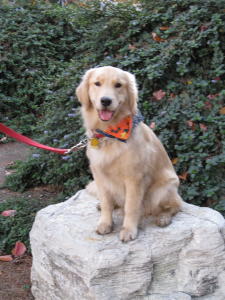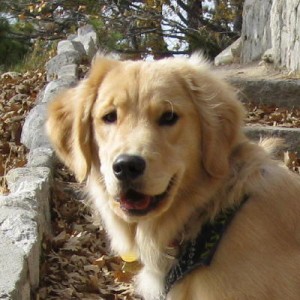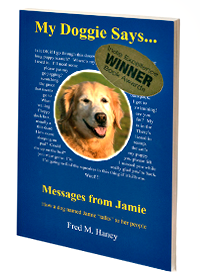Here are some more things your dog might “say†to you on a walk or jog and how to recognize them.
1. “Could we please go this way?†Jamie and Callie never seem to forget a route they’ve taken. Almost every time we come to a “fork in the road,†they take it (to quote Yogi Berra). If they remember that we’ve been down a path before, they start to pull in that direction. So, once in a while, why not let your dog decide which way you’re going to go? It will appreciate getting to be the leader.
2. “May I please jump up on this rock?†This may be Callie’s special thing, since her mom and dad are agility champions. But your dog probably has some favorite thing it likes to do – jump up on a wall, run through some grass, or jump over a low fence. The golf course where Callie runs has a lot of one-foot-high fences for guiding golf carts. Callie loves to do a few “overs†when she sees one of these. Why not let your dog pick out a few entertaining things to do and give it the freedom to “goof off for a minute?
3. “I’d really like to walk on the top of this wall.†Callie seems to have a little “circus performer†in her genes. She likes to run on the top of a stone wall if there’s one around. Jamie had a favorite “tightrope act.†When we ran across the golf-cart-and-walking bridge across one of the golf holes, Jamie didn’t like to run on the slippery rubber mat, so she squoze all four of her doggie paws into the six-inch-wide wooden board along the edge. This was quite a feet-feat. You know how a tightrope walker has to walk with one foot in front of the other. Imagine doing this with four feet – both her hind feet and her front feet moving one in front of the other. She got so close to the chain link safety fence that her ear went “flip-flip-flip†against the wire.
4. “Let’s be smart and walk in the shade.†If you walk your dog on a warm day, be careful not to over-do it. Imagine how you’d feel if you were out walking on a hot day in a heavy fur coat. Next time you’re in this situation, let your dog choose which part of the street to walk on. See if it doesn’t cross the street to be in the shady parts. It might also slow down in the shady parts – to enjoy the cool air – and speed up in the sunny spots – to get to the next shady spot faster.
5. “OK, we’ve arrived at our destination.†Chances are your dog knows its way home. Next time your dog out for a walk, don’t lead it into your home. Let your dog take the lead and see if it recognizes home when you get there. Or, if you’re headed for a destination, see if your dog recognizes it when you get there. Jamie loved to walk to our boat dock at Lake Arrowhead. She knew the route from the street to our boat dock, and she knew exactly which dock was ours. She even knew which storage box held her floating Frisbee – which was her favorite thing to retrieve. She also recognized The Wishing Well, a gift shop at Lake Arrowhead Village, that always has a doggie water dish and very large and tasty puppy treats. Jamie pulled us clear across the Lake Arrowhead Village parking lot to get to The Wishing Well.
Your dog needs to know that you are the alpha animal. But try letting it take the lead once in a while; you can still be the alpha figure. Your dog will grow in confidence and personality, and it might reveal talents and interests you didn’t know it had.






















